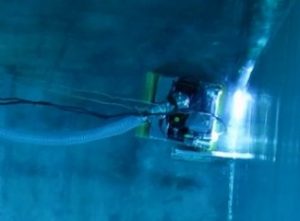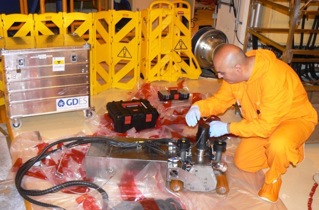Posted in News GD 1-2015v | Tagged News GD 1-2015v “Demos”, a new system that reduces radiation doses by 60% during nuclear power plant decontamination

One of the activities that GD Energy Services (GDES) has been involved in over the years and in which radiation levels are important is the decontamination of nuclear power plant cavities. The radiation levels may increase considerably if the fuel assemblies have been previously damaged.
 For this reason, for the last two years GDES INNOVATION has been addressing the development of the DEMOS robot from its facilities at the Valencia Polytechnic University’s Polytechnic City of Innovation. DEMOS is a system for the decontamination of the walls and floor of the cavity with the latter flooded.The main objective of decontaminating the cavity is to provide the workers performing tasks inside it, or above it, during refuelling outages with the best possible radiological conditions. Consequently, the objectives sought with this decontamination are as follows:
For this reason, for the last two years GDES INNOVATION has been addressing the development of the DEMOS robot from its facilities at the Valencia Polytechnic University’s Polytechnic City of Innovation. DEMOS is a system for the decontamination of the walls and floor of the cavity with the latter flooded.The main objective of decontaminating the cavity is to provide the workers performing tasks inside it, or above it, during refuelling outages with the best possible radiological conditions. Consequently, the objectives sought with this decontamination are as follows:
• To remove the largest possible amount of activity from the cavity and areas in which there has been a stripping of soluble and insoluble oxides, for example the passage of the fuel assemblies from the reactor core to the fuel storage pools on the refuelling platform.
• To reduce radiation levels in the cavity during vessel closure activities.
• To reduce removable surface contamination.
• To maintain acceptable radiological conditions in the cavity in order for collective and individual doses and the risk of surface contamination to be kept as low as possible during vessel closure activities.
Furthermore, being able to work with the cavity flooded, in parallel with other activities, allows action times to be reduced on the critical path of the refuelling outage schedule.
DEMOS has been used effectively during refuelling outages at the Trillo and Cofrentes nuclear power plants, with excellent results in both cases and a reduction of more than 60% of the foreseen dose traditionally assigned to work in and over the reactor cavity.

